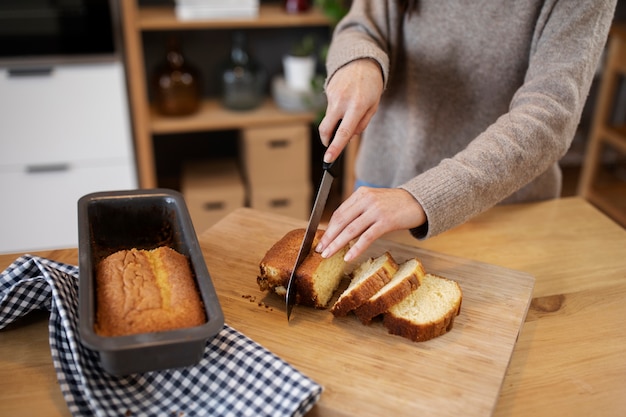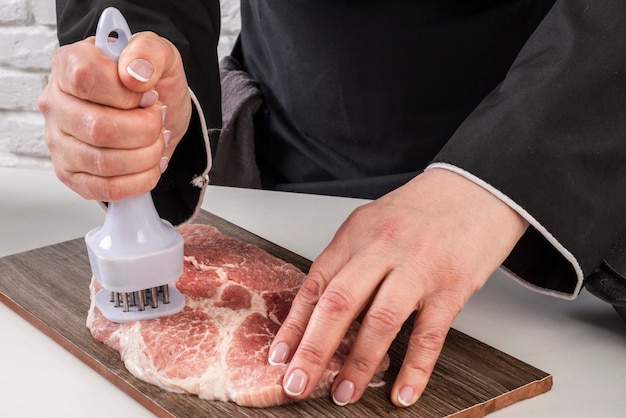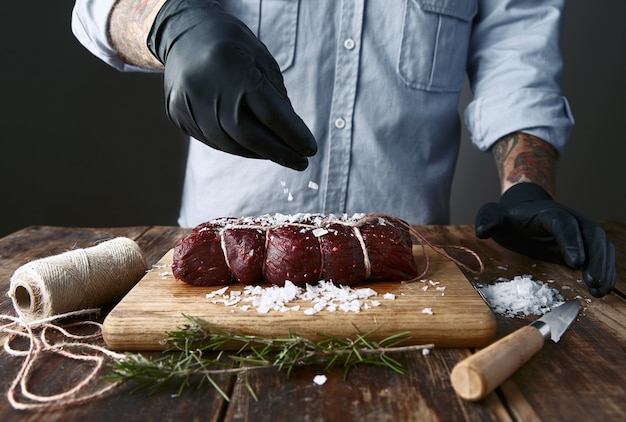I've been a meatloaf enthusiast for years, experimenting with countless recipes passed down from my grandma to modern, gourmet creations. But there's one element that always throws a wrench in my cooking: the temperature. It's a constant source of debate in my family, with everyone claiming their own method is the ultimate truth. This got me thinking – why not delve into the science behind it all? I wanted to uncover the secrets of perfect meatloaf, exploring different meat types, internal temperatures, and the role of the oven itself.
So, join me on this journey to find the sweet spot for cooking a delectable meatloaf. We'll unravel the mysteries of temperature and discover how to achieve that juicy, flavorful, and safe result you crave.
(Part 1) The Importance of Internal Temperature

Understanding the Science: A Journey into Protein Denaturation
cooking meatloaf to the correct internal temperature isn't just about avoiding a nasty case of food poisoning. It's about unlocking the full potential of flavor and texture. You see, when you heat meat, the proteins undergo a transformation called denaturation. This process is what creates the changes in texture and color we associate with cooked meat.
Think of it this way: when you apply heat to your meatloaf, the protein molecules unravel and rearrange. This results in the transformation from a raw, soft texture to a cooked, firm texture. The key is to cook it to a point where the proteins have denatured enough for safe consumption, but not so much that it becomes dry and tough.
The Magic Number: 160°F (71°C) – The Gold Standard for Safety
The USDA recommends cooking ground meat to an internal temperature of 160°F (71°C) to ensure the elimination of harmful bacteria. This applies to all types of ground meat, including beef, pork, chicken, and turkey. This is the minimum temperature for safety, and many people find that cooking to this temperature results in a slightly dry meatloaf.
Personally, I prefer to cook my meatloaf to 165°F (74°C) for a more succulent and flavorful result. It's a personal preference that gives me extra peace of mind knowing it's cooked through. However, you're the master chef in your kitchen. Experiment and discover your ideal temperature!
Your Meatloaf's Best Friend: The meat thermometer
When it comes to meatloaf, ditch the "eye test" and embrace the trusty meat thermometer. This little tool is your best friend in the kitchen. Insert it into the thickest part of the loaf, making sure it doesn't touch any bones. Keep it there for a few seconds to get an accurate reading.
(Part 2) Factors Affecting Meatloaf Cooking Temperature: A Deeper Dive

Meat Type: A World of Flavor and Texture
The type of meat you use in your meatloaf can significantly affect the cooking temperature and time. For example, ground beef typically requires a longer cooking time compared to ground pork. This is because different meats have varying protein structures and fat content.
Here's a breakdown of common meat types and their recommended cooking temperatures:
| Meat Type | Internal Temperature (°F) | Internal Temperature (°C) |
|---|---|---|
| Beef | 160 | 71 |
| Pork | 145 | 63 |
| Chicken | 165 | 74 |
| Turkey | 165 | 74 |
Always remember, it's best to err on the side of caution and ensure the internal temperature is reached for the highest level of safety.
meatloaf size and Shape: A Culinary Balancing Act
The size and shape of your meatloaf can also play a significant role in the cooking time and temperature. A smaller meatloaf will cook faster than a larger one. A flat, thin loaf will cook more evenly than a thick, round loaf.
If you're unsure, it's a good idea to check the internal temperature in several places to ensure the entire loaf is cooked through.
Oven Temperature: The Foundation of Even Cooking
The oven temperature is the foundation of even cooking for your meatloaf. While the standard recommendation for meatloaf is 350°F (175°C), you might need to adjust it based on your oven's quirks and the size of your meatloaf.
Here's my secret weapon: always preheat your oven thoroughly before putting the meatloaf in. A well-preheated oven ensures even cooking and prevents the loaf from being undercooked in the middle.
(Part 3) Choosing the Right Cooking Method: Unveiling the Possibilities

Oven Baking: The Classic Approach
Oven baking is the traditional method for cooking meatloaf. It's a simple and straightforward technique that allows for even cooking and a beautiful golden-brown crust.
Here's how I usually bake my meatloaf:
- Preheat oven to 350°F (175°C).
- Shape the meatloaf in a loaf pan or on a baking sheet.
- Bake for 45-60 minutes, or until the internal temperature reaches 160°F (71°C).
slow cooking: A Hands-Off Culinary Symphony
For a more relaxed approach, slow cooking offers a wonderful alternative. The low and slow cooking process ensures a tender and juicy meatloaf.
Here's how to slow cook your meatloaf:
- Shape the meatloaf and place it in the slow cooker.
- Cook on low for 6-8 hours or on high for 3-4 hours, until the internal temperature reaches 160°F (71°C).
Grilling: Adding a Smoky Twist to Your Meatloaf
Grilling meatloaf might seem unconventional, but it can be a surprisingly delicious and easy method. It adds a smoky flavor and lovely grill marks, creating a visually appealing and flavorful dish.
Here's how to grill your meatloaf:
- Preheat your grill to medium heat.
- Shape the meatloaf and place it on the grill.
- Cook for 30-40 minutes, turning every 10 minutes, until the internal temperature reaches 160°F (71°C).
Remember to adjust cooking times based on the thickness of your meatloaf and the heat of your grill.
(Part 4) The perfect meatloaf recipe: A Culinary Masterpiece
Now, let's dive into a recipe that I absolutely adore. This recipe is the result of my culinary journey, incorporating all the knowledge we've learned about cooking temperature, meat type, and baking methods.
Ingredients:
- 1.5 lbs ground beef (80/20 mix)
- 1 cup bread crumbs
- 1/2 cup milk
- 1 large egg
- 1/2 cup chopped onion
- 1/4 cup chopped green bell pepper
- 1/4 cup ketchup
- 1 tablespoon Worcestershire sauce
- 1 teaspoon dried oregano
- 1/2 teaspoon salt
- 1/4 teaspoon black pepper
Instructions:
- Preheat oven to 350°F (175°C).
- In a large bowl, combine all ingredients and mix thoroughly.
- Shape the mixture into a loaf and place it in a loaf pan.
- Bake for 45-60 minutes, or until the internal temperature reaches 160°F (71°C).
- Let the meatloaf rest for 10 minutes before slicing and serving.
Tips for a Perfect Meatloaf: Elevate Your culinary skills
- For extra moisture, add a few tablespoons of chopped bacon or diced vegetables like mushrooms or carrots to the meatloaf mixture.
- To create a delicious crust, spread a thin layer of ketchup or barbecue sauce over the top of the meatloaf before baking.
- For added flavor, add a sprinkle of smoked paprika or cayenne pepper to the meatloaf mixture.
(Part 5) Common Mistakes and Troubleshooting: Avoiding Culinary Disasters
Even with the best intentions, things don't always go according to plan in the kitchen. Here are some common mistakes to avoid and how to troubleshoot them:
Overcooked Meatloaf: A Culinary Tragedy
Overcooked meatloaf can become dry and crumbly. To prevent this, ensure you don't cook it for too long and check the internal temperature regularly. If it's already overcooked, you can try to salvage it by adding a generous amount of sauce and serving it with mashed potatoes or other creamy sides.
undercooked meatloaf: A food safety Nightmare
Undercooked meatloaf poses a serious food safety concern. Always check the internal temperature to ensure it has reached the recommended 160°F (71°C). If it's undercooked, return it to the oven and continue cooking until it reaches the safe temperature.
Unevenly Cooked Meatloaf: A Culinary Balancing Act
Uneven cooking can result in a meatloaf that's overcooked on the outside and undercooked in the middle. To avoid this, use a thermometer to check the temperature in different parts of the loaf. You can also try rotating the loaf halfway through the cooking process.
Dry Meatloaf: The Quest for Moisture
A dry meatloaf can be caused by overcooking or insufficient moisture in the mixture. To prevent this, make sure you're using moist ingredients like bread crumbs soaked in milk and add a tablespoon or two of chopped bacon or ground sausage to the mixture.
Crumbly Meatloaf: Finding the Right Binding
A crumbly meatloaf can result from using too little binder like eggs or breadcrumbs. Make sure you're using the recommended amount of these ingredients for a cohesive loaf.
(Part 6) Serving Suggestions: A Culinary Symphony of Flavor
Now that you've mastered the art of cooking the perfect meatloaf, let's talk about how to serve it.
Classic Sides: Time-Honored Combinations
Meatloaf is a versatile dish that pairs well with a variety of classic sides. Here are a few of my favorites:
- Mashed potatoes
- Gravy
- green beans
- corn on the cob
- Macaroni and cheese
Modern Twists: A Contemporary Approach
For a more contemporary approach, you can try serving meatloaf with some of these sides:
- Roasted vegetables
- quinoa salad
- grilled asparagus
- sweet potato fries
flavor combinations: A World of Culinary Possibilities
Don't be afraid to experiment with different flavors and create your own unique combinations.
Here are a few ideas to get you started:
- Mediterranean: Serve meatloaf with roasted peppers, olives, and feta cheese.
- Asian: Try a meatloaf with a sweet and savory glaze and serve it with stir-fried vegetables and rice.
- Tex-Mex: Combine meatloaf with black beans, corn, and jalapenos.
(Part 7) Meatloaf Storage and Reheating: Preserving Your Culinary Creation
After all your hard work, you'll want to make sure your meatloaf stays delicious and safe to eat.
Storing Leftovers: Ensuring Food Safety
Store leftover meatloaf in an airtight container in the refrigerator for up to 3-4 days.
Reheating: Bringing Back the Flavor
You can reheat your meatloaf in a few different ways:
- Oven: Preheat oven to 350°F (175°C). Place meatloaf in a baking dish and bake for 15-20 minutes, or until heated through.
- Microwave: Place meatloaf on a microwave-safe plate and heat on high for 1-2 minutes, or until heated through.
- Skillet: Heat a skillet over medium heat. Add meatloaf and cook for 5-7 minutes, or until heated through.
(Part 8) FAQs: Your Meatloaf Questions Answered
What if I don't have a meat thermometer?
While a meat thermometer is the most accurate way to check the internal temperature, you can also use a visual guide. When the meatloaf is cooked through, it should be no longer pink in the center and should register a firm texture when poked with a fork.
Can I cook meatloaf in a smaller pan?
Yes, you can cook meatloaf in a smaller pan. Just make sure the pan is large enough to accommodate the loaf and that it has enough space around the edges to allow for even cooking.
Can I freeze meatloaf?
Yes, you can freeze meatloaf for up to 3 months. Wrap it tightly in plastic wrap and aluminum foil and place it in a freezer-safe bag. To thaw, place the meatloaf in the refrigerator overnight.
What if my meatloaf is too dry?
If your meatloaf is too dry, you can try to salvage it by adding a generous amount of sauce and serving it with creamy sides like mashed potatoes or gravy.
Is it okay to cook meatloaf at a lower temperature?
Yes, you can cook meatloaf at a lower temperature, but it will take longer. For example, you can cook it at 325°F (165°C) for 1 hour and 15 minutes, or until the internal temperature reaches 160°F (71°C). However, a lower temperature can result in a less crispy crust.
There you have it, folks! The ultimate guide to meatloaf cooking temperature. Now go forth and create your own delicious masterpieces!
Everyone is watching

Corn on the Cob: The Ultimate Guide to Perfectly Cooked Ears
Healthy MealsAh, corn on the cob. Just the name evokes images of sunny days, barbecues, and that sweet, juicy flavour that ...

Perfect Pork Roast Oven Cooking Time: A Guide to Delicious Results
Healthy MealsThere's something truly satisfying about a perfectly roasted pork. The aroma alone is enough to make your mout...

Ham Cooking Time: How Long to Bake, Smoke, or Boil a Delicious Ham
Healthy MealsAh, ham. It's a classic, isn't it? A real crowd-pleaser, especially around holidays. And when done right, it'...

Scallops: The Ultimate Guide to Perfect Cooking
Healthy MealsAh, scallops. Those delicate, sweet, and utterly delicious morsels of the sea. They hold a special place in my...

Spaghetti Squash: The Ultimate Guide to Cooking and Serving
Healthy MealsRemember that time you saw spaghetti squash at the supermarket, looking all bumpy and strange, and thought, "W...
